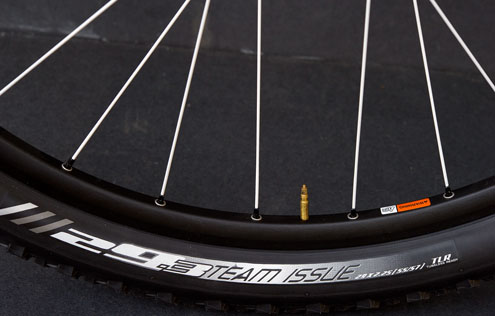Why Is a 29er So Different From a 26er Mountain Bike?
Related: gear, hard core, Inyo National Forest, mountain biking, peak bagging, White Mountain Peak, White Mountains

My extensive mountain biking experience had been all 26er-based until 2011, so this page captures my impressions of the transition to the monster-wheel 29er, reinforced on the all-day epic Trek to the Summit of White Mountain Peak.
29er behavior
A 29er is slower to accelerate due to 11.5% larger diameter/circumference wheels (29 vs 26). Necessarily stronger and heavier wheels and tires are typically more like 25% heavier than the wheel diameter would suggest (since the area is ~25% larger, and the larger diameter requires extra strength).
A 29er is less agile than a 26er, so a 29er cannot make tight quick turns or even rapid changes in direction like a 26er can, especially at speed. As compensation, a 29er is notably more stable at speed, and rolls over the rough stuff with much greater ease, an ease that will almost certainly surprise anyone used to 26" wheels.
Whether a 29er or a 26er is “better” depends greatly on the type of riding; tight twisty stuff is better done with a 26er, but anything a bit nasty that needs to be rolled over is so much easier on a 29er.
Re-read the above— that “small” change in wheel size means that at least with tubeless tires, one can smash into curbs and roll right over them (as an example). Quite unlike a 26er, for which that maneuver would result in unpleasant consequences, though tubeless on a 26er does mitigate the issue somewhat.
In short, a 29er lets one become a bit sloppy with obstacles, just as a dual suspension bike affords not sweating most of the bumpds that will be quite unpleasant on a hard-tail— the suspension soaks up what you’d otherwise have to soak up with your own legs and body.
When dual suspension is combined with a 29er with tubeless wheels, then you have the ultimate plush ride which can roll over stuff that will make one a bit nervous on a 26er hard-tail.
Momentum and traction
The greater physical momentum of the larger wheels lends considerable extra stability to descents, making for a very stable and easy to manage ride— not hot-rod-like as some racing geometry 26er bikes can be.
When I descended the fast Spring Ridge fire road in the Windy Hill Open Space Preserve near my home (a 40mph descent), I was impressed at just how easy it was to keep the bike exactly on track with far less attention needed to bumps and divots in the road. It’s a lot easier. This same feel was driven home to me during the Trek to the Summit of White Mountain Peak.
While total traction available from the 29" tires is greater than a 26er, one can become overconfident on descents because the wheel momentum feels so stable, but grip is grip, so pay attention, since wheels can still wash-out and lose grip just like with a 26er.
Gearing and climbing
For the same chainring/cassette combination, the gearing of a 29er bikes is effectively about one (1) gears harder than a 26er (11% = 29/26). Thus, a 27-tooth chainring is about equivalent to a 30-tooth chainring on a 26er.
For example, if one rides an XTR 28 X 40 dual chainring on a 26er, choose a 26 X 38 on a 29er for roughly equivalent.
Sprinting
Springing on a 29er does not feel satisfying to me; the bike feels large and sluggish compared to a 26er. But once up to speed, the 29er feels more efficient and stable, so it’s a mixed bag.
Which is best? 26" or 29"?
The type of riding provides the answer. If the riding is smooth trails and fire roads at moderate speeds with tight turns and switchbacks, a 26er offers a more agile feel— and that agile feel might be a very important quality that some riders will have a hard time abandoning.
Pick up the speed, add divots and bumps and washboard surfaces, switch to loose rocks and gravel, and then a 29er rally begins to shine (both climbing and descending), substantially reducing the rider attention needed to “clean” the obstacles. This point was driven home repeatedly during my Trek to the Summit of White Mountain Peak, where the Trek Gary Fisher SuperFly 100 Elite quickly gained my favor over the Trek Top Fuel 9.9 SSL, both up and down.


